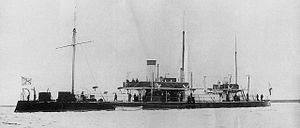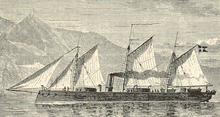Smertsch (1864)

|
|
|---|---|
|
|
|
| Builder: | Admiralty Shipyards, St. Petersburg |
| Keel laying: | August 1, 1863 |
| Launch: | June 11, 1864 |
| Commissioning: | June 5, 1865 |
| Period of service: | 1863-1959 |
| Displacement: | 1560 t |
| Length: | 57.91 m |
| Width: | 11.0 m |
| Draft: | 3.2 m |
| Drive: | two compound steam engines 2 flame tube boilers 2 screws 700 hp |
| Speed: | 8.3 kn |
| Range: | |
| Crew: | |
| Armament: | Guns:
1867:
1870: |
Smertsch ( Russian Смерч , transliteration Smerč; German tornado ) was the name of a gunboat of the Imperial Russian Navy . The boat was built in St. Petersburg in 1864 . Due to its construction, the Smertsch is also known as a monitor . The construction principles developed with the Smertsch , especially those of the gun turrets, were used in the construction of the following Russian gunboats and armored frigates. Last but not least, the Smertsch demonstrated the superiority of the Cowper Phipps Coles tower construction over that of John Ericsson . The Smertsch was in service with the Russian and Soviet navies from 1865 to 1959.
history
At the beginning of 1863 the gunboat Rolf Krake was laid in Glasgow at the shipyard of Robert Napier & Sons . This vehicle, equipped with two gun turrets and built on the basis of an order from the Danish Navy, represented a significant leap in development compared to the American Passaic class. In the summer of 1863 the shipyard offered the Russian Navy type for use in the Baltic Sea . After the approval of the Russian naval command, the contract for the construction of the boat Smertsch on the Admiralty Shipyards (Galley Island) in St. Petersburg was concluded on June 13, 1863 according to the Rolf Krake project . For the license to build the turrets, the Department of the Navy paid £ 259 and 17 shillings to Coles, the turret designer. Construction began on August 1, 1863, the launch was just under a year later on June 11, 1864. On June 5, 1865, the boat was put into service as an armored tower boat (башенная броненосная лодка). On February 1, 1892, it was reclassified as a coastal armored ship . On December 20, 1903, the Smertsch was deleted from the fleet list, disarmed and placed in a preserved state, but in October 1909 it was depreserved and re-commissioned as the Hulk . During the First World War , the Soviet-Finnish War and the Great Patriotic War , the boat was used as a warehouse for mines and torpedoes . In April 1918 the boat was confiscated by the German troops in the port of Helsingfors , but after the peace treaty of Brest-Litovsk it was returned to Russia on May 18, 1918 and transferred to Kronstadt . On October 7, 1941, the Smertsch sank in German artillery fire during the siege of Leningrad , but was already lifted and repaired by the rescue service of the Baltic Red Banner Fleet in 1942 . On September 24, 1959, the boat was finally deleted from the fleet list and then scrapped.
During its service the boat had different names. In detail these were:
- until October 14, 1909 Smertsch (Смерч)
- from October 14, 1909 to 1923 Block Ship No. 2 (Блокшив №2)
- from 1923 to January 1, 1932 Block Ship No. 3 (Блокшив №3)
- from January 1, 1932 to May 16, 1946 Block Ship No. 1 (Блокшив №1)
- from May 16, 1946 BSch-1 (БШ-1)
construction
The Smertsch had two Coles system turrets. The loopholes in the parapet were practically at the level of the upper deck. The armor of the towers consisted of a layer of 114.3 mm thick armor plates, which were fastened with vertical studs. Initially, the idea was to double-layer the armor on the front of the towers. However, there were practical problems with the attachment. Ultimately, both layers were supposed to be attached with the same bolts, which ultimately led to the inner layer being omitted and the original outer layer being reinforced to 152.4 mm. The armor was backed with two layers of teak with a thickness of 203 and 102 mm. This should prevent parts of the brittle armor from flaking off when hit. In addition, the inner sides of the towers were covered with iron plates with a thickness of 25.4 mm. The armor was made in England and the armor plates came from different manufacturers. The hull was armored 102–114 mm, the deck had an armor of 25.4 mm.
Initially, it was planned to equip the towers with 60 pounder smoothbore cannons. However, through the introduction of rifled guns, the fighting power of the ironclad could be increased significantly. Therefore, a 203-mm cannon was installed in each tower. As early as 1870, these guns, as well as on the monitors of the Bronenossez (Броненосец) type, were replaced by more modern guns of the 229 mm caliber. In addition there were two 37 mm Hotchkiss cannons and two four-pounders. The Smertsch side straightener was driven by an auxiliary steam engine with an output of 6 hp. There was a separate boiler system for this auxiliary steam engine.
The boat was propelled by two steam engines with two propellers. The steam engines also came from England and were manufactured by Maudsley, Sons & Field . They made 700 hp. The steam was generated with two flame tube boilers. The top speed was 8.3 knots.
The displacement of the Smertsch was 1560 t. The boat was 57.91 m long, 11 m wide and had a draft of 3.2 m.
Remarks
- ↑ Amichranov gives 1864 for commissioning, but 1865 seems more plausible because of the necessary equipment work
- ↑ Amichranov gives the summer of 1864 for the proposal, but since construction began in August 1863 and the contract was concluded in June 1863, this cannot be correct
- ↑ The crooked dimensions result from the fact that metric units of measurement were not in use in Russia at the time. 25.4 mm correspond to the Russian length measure Djuim (Дюйм) or 1 inch
literature
- Л. И. Амирханов: Артиллерия российских мониторов . Гангут, Санкт-Петербург 1998 (LI Amichranov: The Artillery of Russian Monitors . Gangut Publishing House, St. Petersburg 1998)
